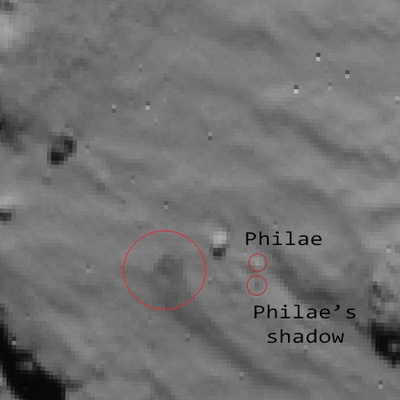Philae spotted after first landing on 67P
The images were provided by ESA's Flight Dynamics team on Friday, who sent them to the web team to be published as soon as possible: we all wanted to make sure you saw them right away. Once we had convinced ourselves that the dark 'splotch' seen in the second of the images was almost certainly the tell-tale signature of Philae's precise first touch-down and bounce, we put them out.
However, some careful work by a number of people in ESA's Flight Dynamics team and by followers of our Rosetta blog has shown that these NAVCAM images show more, namely Philae itself, just after the bounce!
It appears as a couple of brighter pixels closely accompanied by its shadow in the form of a couple of darker ones just below, both to the right of the diffuse dust cloud shadow.
Credit for the first discovery goes to Gabriele Bellei, from the interplanetary division of Flight Dynamics, who spent hours searching the NAVCAM images for evidence of the landing.
Once the images were published, there was also quite some speculation by Rosetta blog readers in the comments section, wondering which features might be attributable to the lander. Martin Esser, Henning, and Kasuha in particular were among the first to make insightful observations on the topic, although many others have since joined in.
Last but not least, a careful independent review of the images was made by Mikel Canania from the earth observation division of Flight Dynamics, with the same conclusion. He also made the annotated animation shown here.
So very well done, Gabriele and Mikel from Flight Dynamics, as well as Martin, Henning, Kasuha, and everyone else from the blog: thank you from all of us for helping spot Philae!
P.S. Note that in our rush to share these exciting images with you on Friday, we made a couple of small errors in the labels and text; those have been updated now. In particular, the image that was indicated to have been taken at 15:30:32 UTC, just before touchdown, was actually an image taken at 16:30:32 UTC, about an hour after touchdown. This should indeed have been clear from the obviously changed illumination conditions, but the web team were very tired at the time.
Also, Flight Dynamics have clarified that the green spot on Friday's images is actually the computed touchdown point based on data taken during the deployment and descent to the surface, not the originally intended landing point. Nevertheless, it's still very close to the latter, again a testament to the excellent work done by Flight Dynamics.
